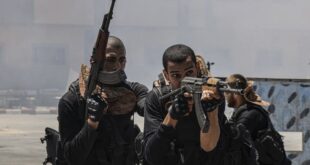GENEVA (AFP) — An international conference was mired Wednesday, as efforts continued to break a deadlock after a Muslim challenge to moves to facilitate Israeli membership of the global Red Cross movement.
Mediators were hunting for a compromise that would satisfy both Muslim countries and supporters of Israeli accession, who make up the majority.
The aim was to avoid a divisive vote at the conference of the 192 signatory nations of the Geneva Conventions and their respective national societies which make up the global Red Cross and Red Crescent movement.
“There is a strong commitment from the states and the national societies present to find a positive solution to be adopted by consensus,” said conference Chairman Mohammed Al Hadid, the head of the Jordanian Red Crescent.
“We are working towards this solution and we are hearing all sides,” he said, adding that he was remained “confident” of eventually ending the impasse.
Members of the Organisation of the Islamic Conference held up the gathering on procedural grounds for several hours on Tuesday’s opening day.
Pakistan and Tunisia also lodged a formal proposal calling on the meeting to confirm that the movement’s rules apply to Israeli-controlled Arab areas.
The proposal, which said that they fall within the respective jurisdiction of the Palestinian, Syrian and Lebanese Red Crescent societies, marked a diplomatic protest against Israel.
Pakistan and Tunisia proposed adding the wording — which was unacceptable to Israel — to a broader resolution on whether to change the statutes of the international Red Cross and Crescent movement to add a new “red crystal” emblem.
Changing the statutes would cement a deal from a conference last December, which capped painstaking negotiations to end a 56-year row and allow Israel’s Magen David Adom (MDA, Red Star of David) into the international network.
The MDA was officially not recognised in the Geneva Conventions, even though Israel is a signatory, because its emblem did not conform with longstanding rules allowing only a cross or a crescent.
The Palestinian Red Crescent was also excluded because the statutes only allow relief societies from sovereign states to join.
That rule is also up for change.
The new crystal — in fact a red outline of a square standing on edge — is also meant to have a wider role for Red Cross and Crescent humanitarian workers in other areas where there is a need for a emblem that is free from religious or political connotations.
Opposition from Muslim countries led by Syria at last year’s conference sparked a brusing vote, in a break from Red Cross tradition.
The conference backed the new emblem 98-27, opening the way for the statute change. The remaining governments abstained or did not take part.
 Eurasia Press & News
Eurasia Press & News
